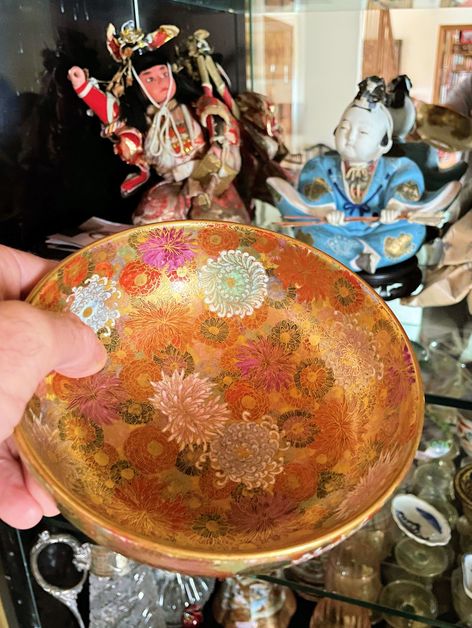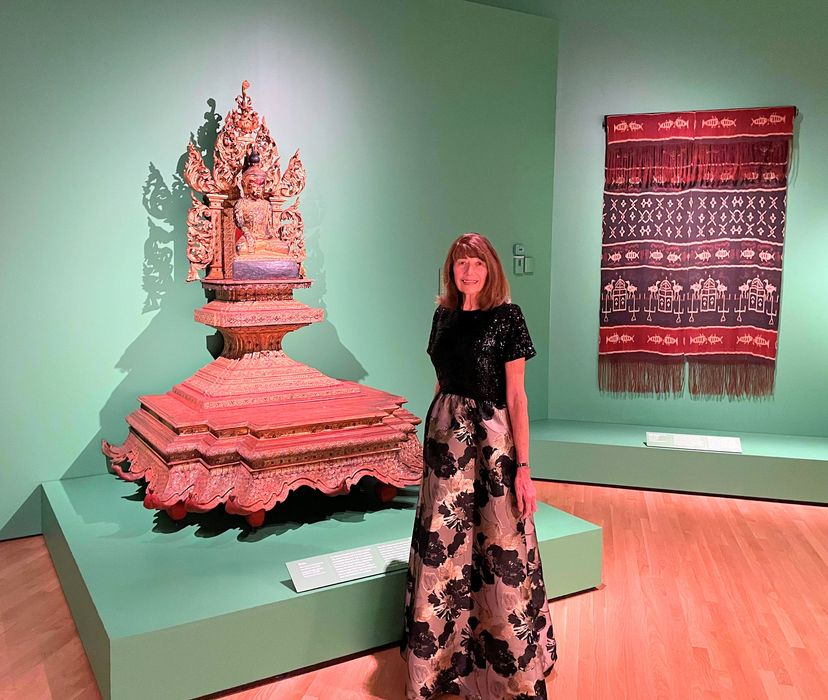A LOVE OF JAPANESE ANTIQUES. HOW MY MOTHER’S CERAMIC BOWL AND A FAVORITE GARDEN WERE AN INSPIRATION.

Even as a small boy I admired this Satsuma bowl in my Mother’s china cabinet and it was an early catalyst for my interest in Japanese antiques. We often visited the Japanese Tea Garden in Golden Gate Park and this too propelled me on a collector’s journey. Many of us have big and small collecting passions which we immerse in for months, a year or two, …or even a lifetime. These early events opened my eyes to the arts and culture of Japan along with China, Southeast Asia, and Indonesia.

Channeling my inner Samurai during a trip to San Francisco’s Japantown years ago.

I was inspired by this Meiji period woodblock print.

One of my favorite things growing up in the Bay Area was visiting Gump’s department store on Union Square with my Grandmother and Mom in San Francisco. I’ll always remember the golden Qing dynasty wooden Buddha on the first level. My love of all Asian antiques just exploded during this time and continues to this day. The story of Gumps and this amazing Buddha would make a fabulous documentary! The Buddha was sold at a Hong Kong auction in May 2019 for $3 million U.S. dollars!

I’m in front of an amazing Buddha Sculpture in the Japanese Tea Garden. Known as “Amazarashi-No-Hotoke” the 1 1/2 ton sculpture was cast in 1790 in Tajima, Japan. It was displayed in the Gump’s store for 15 years before they donated it in 1949.

We began collecting “Mingei”, or small folk items, like dolls, lacquer boxes, and Ikebana baskets.

This is our very favorite piece. It is a Meiji period, Keyaki wood “Sendai Isho-dansu” clothing tansu with a ‘Bo’ locking piece. We found it at a wholesale Japanese antique warehouse in South San Francisco. When we saw it on the floor we immediately said,…”It is ours!”


I’m fascinated by musha ningyo “Gogatsu” or “Boys Day” hero dolls. This is a display of “Yoroi” (armor) and “Kabuto” (helmet). This piece is displayed on a Sendai chest.

We use this very large futon-dansu in a bedroom for storing clothing as well as a TV.


Our twin granddaughters have always been drawn to this tansu chest.

The grandsons as well.

We hang this Meiji period marital futon cover on our staircase. The hand printing technique is called “tsutsugaki.”
The turtle (kame) is said to live 10,000 years and is one of the four celestial guardians (dragon, phoenix, tiger, and turtle) of Chinese mythology. The wavy lines behind their shells represent seaweed that has attached over millennia. Supposedly it takes five thousand years to accumulate the amount of seaweed worn by each of the sea turtles. The pine branches symbolize life, longevity, and rebirth. Good omens for the new married couple.

“Kibori kuma” or Ainu folk craft bear (Higuma) carvings from Hokkaido. The Ainu are an East Asian ethnic group indigenous to Japan and the original inhabitants of Hokkaido.

A Meiji period “Musha-ningyo” Boys Day doll of the infamous “Yoshitsune” in full armor with “Benkei”, a warrior monk. The faces have many coats of “Gofun”, a powder made from crushed oyster shells.


In 1991 Marla and I opened a Wesco Fabrics’ showroom in the Denver Design District. We knew we needed to differentiate ourselves from the other fabric and furniture showrooms. We loved Japanese antiques so we brought in pieces to add to our showroom product mix. In my next blog post, I’ll take you on buying trips to Japan where we sourced many of our unique items. As the years went on we also sourced furniture and accessories from China, Southeast Asia, Indonesia, France, and Holland. It was an amazing adventure!

We return to the Japanese Tea Garden nearly every trip to San Francisco. I see something new or from a different perspective each time.

Marla is with our grandson Vaughan by the Temple Gate. We have a tradition of taking the Grandchildren to visit the Bay Area and San Francisco on what we call the “9-Year-Old trip.”

Everyone always loves going over the famous “Drum Bridge.” The bridge was designed by master shrine builder Shinshichi Nakatani and built in Hiroshima-ken, Japan. It was then shipped to San Francisco for the 1894 World’s Fair.
San Francisco’s Japanese Tea Garden was originally developed for the 1894 World’s Fair in San Francisco. It was conceived and designed by Baron Makoto Hagiwara, a wealthy landscape designer. Hagiwara’s descendants maintained the Japanese Tea Garden until the start of the second world war. At the time, America went to war with Japan and had begun sending anyone of Japanese descent into temporary internment camps. Without the Hagiwara family, the Japanese Tea Garden was not kept and fell into ruin. During this time, it was renamed the Oriental Tea Garden. It was eventually reinstated as the Japanese Tea Garden in 1952.

With grandson Owen and our good friend, Lea. She and Marla have been friends since junior high school and were Delta Gamma sorority sisters at the University of the Pacific.

Grandsons Logan and Paxton on the bridge.

A fascinating view of the architectural style of the entrance gate.

Logan, Marla, and Paxton walking across the “Main Pond.”


Time for a tea break in the Tea House.

A beautiful view of a lantern and the Main Gate entrance.
Next week I’ll post on our journey to find interesting antiques and accessories for our showroom in Japan over the years. It was a real adventure.
Photos: Dick Gentry. Not to be used without permission.
About The Author
admin
Related Posts
THE PHOTOGRAPH…PART 1
Taking a photograph is my way of holding on to life, and to keep a…
January 8, 2021WATCHING THE WONDERFUL “SHOGUN” HISTORICAL TV SERIES AND OUR LOVE OF JAPANESE CULTURE & ANTIQUES
One our very favorite TV shows in 2024 is “Shogun” on Hulu. It…
January 8, 2021

Roger Clark | 15th Jan 21
Ah Richard-san, anata wa ichiban.
When living in Thailand we purchased a large porcelain Vietnamese elephant. We still have it along with a stone budda head and iron hands purchased in Cambodia. This is all we have left from this period of our life besides a tremendous amount of photographs.
And I know what you mean about Japanese art. For 20 years I worked for a high tech company that was 49% owned by Fujitsu Ltd. I traveled to Japan at least 4 times a year and extensively travel the back roads whenever I could. I became the company’s unofficial Japan tour guide for the newbies and became very close friends with my Fujitsu counter parts and their families. Hopefully I can return to Japan in 2021 to reconnect.
Sayonara,
Roger-san
admin | 19th Jan 21
Roger-san, great memory of your Japanese adventures and travels. Thanks for sharing!